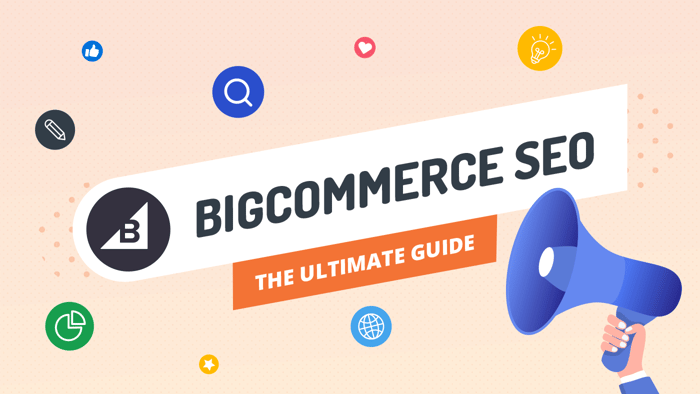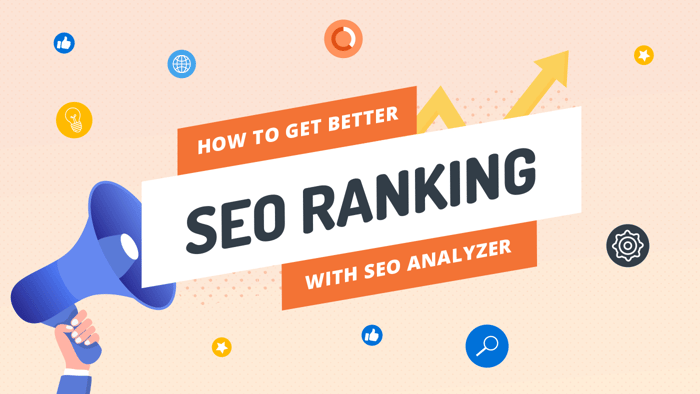This article focuses on BigCommerce SEO strategies. You’ll learn how to optimize your online store for Google, get the most out of what BigCommerce offers in this area, and maximize your e-commerce website’s potential.
Imagine a world in which no one knows about “Forrest Gump.” The film exists, but no one can find it. Maybe this is some dystopian future where people are subjected to such a firehose of media that even the most brilliant stories are barely remembered after a few weeks. Buried under the debris of forgotten culture is the hidden gem, “Forrest Gump” – lost forever.
That’s what a BigCommerce store without SEO (search engine optimization) might be – a gem like “Forrest Gump,” but out of everyone’s sight and impossible to find. SEO is the key to unlocking your website’s visibility on the Internet.
Table of Contents
BigCommerce’s SEO Features
BigCommerce is one of the most SEO-aware e-commerce solutions. The platform’s appreciation for SEO is clearly reflected in its varied native search engine optimization features, such as:
SEO-friendly URLs: These are short, descriptive, and easily readable URLs that contain keywords and follow Google’s – still the biggest and most important search engine – recommendations.
Unique URLs: Each unique page has a unique URL, thus avoiding penalties for duplicate content.
Microdata: Product pages include rich snippet information, such as ratings, pricing, and stock levels.
URL rewrites and 301 redirects: If you rearrange pages or change a product and, by extension, product page names, BigCommerce automatically rewrites the pages’ URLs to match these changes and redirects visitors to the new URL.
Robots.txt editing: BigCommerce makes it easy to edit the robots.txt file so that you keep search engine crawlers off some of your pages because not every online store page should be indexed and discoverable – cart, checkout, and login pages being clear examples.
CDN (content delivery network): When a network of globally distributed servers works together to let the server geographically closest to your visitor serve them the content they search for, that’s a CDN doing wonders for your website’s load speed (especially important for pages rich in images and visuals).
Advanced reporting and analytics: BigCommerce enables you to make sense of your online store’s data and make informed marketing and sales decisions based on reports about user behavior and your store performance, such as customer, purchase funnel, and cart reports.
These built-in SEO features help you optimize your product, category, and other store pages for online searches and become visible to your target audience. And your BigCommerce SEO strategies should definitely include them.
However, BigCommerce doesn’t stop there. It offers a bunch of third-party SEO apps that you can integrate with your store to boost your SEO game.
Your BigCommerce Online Store
 The Basics
The Basics
Most of what you do with your BigCommerce store affects, in one way or another, how easy it is for people to find you online. It also affects the probability of visitors staying longer and answering your calls to action or leaving as soon as they land on a page.
For users to find you, for starters, you need solid basics. When you take care of these basics, keep in mind that BigCommerce will help you cover the more technical aspects, such as setting up a store, designing it, adding cart buttons, and more.
1. About Us
Your store should have an About Us page that tells the story of your business and product or service. And this story had better be good and short enough that people want to read it. Follow the approach biopics often take: Stick to the facts – but dramatize creatively!
Write about that unique element that sets you apart from the thousands of other online shops. For instance, describe what led you to open the store in the first place. Yes, a good origin story doesn’t just work for Marvel movies! And don’t forget to sprinkle a few keywords here and there.
In any case, think of your About Us page as a short biography of your shop. Would you read a dry and lifeless, never-ending biography?
2. Social Media Links
Add links if you have a social media presence. If you don’t, it’s time to do something about that!
Active social media profiles – profiles that post regularly without spamming other people’s digital spaces – help with credibility. They attest to the veracity of your About Us story and show that you really are who you say you are, removing the shadow of doubt in users’ minds.
But post regularly; an existing but inactive business social media profile is as shady as it gets.
3. Contact Us
A contact page is essential. Your actual and potential customers must have an easy way to reach out to you and find answers to their questions and concerns. Whether it’s general inquiries, delivery dilemmas, product queries, complaints, or something else, you must be there for them.
4. Delivery and Shipping
A delivery and shipping page plays an important informational role, anticipating customers’ questions regarding... well, delivery and shipping.
For instance, if you sell physical products, provide information on the shipping mode, typical delivery time, delivery locations, shipping rates, and more.
5. Terms and Conditions
A terms and conditions page is necessary for both you and your audience. Terms and conditions lay out the rules by which you and your audience enter, maintain, and exit a relationship.
When you clearly define the rights and responsibilities of everyone involved, you avoid unnecessary complications and even conflicts, limit your liability, and prevent abuse, among other things.
6. Cancellation and Return Policies
What happens if a customer changes their mind about a service you offer and wants to cancel it? What should someone expect if, instead of a beautifully illustrated coffee mug, they receive broken porcelain?
You can’t let customers guess the answers to these and similar questions. You need a clearly written cancellation and return policies page that details how you handle cancellation requests, refunds, delays in delivery, bad deliveries, and other sensitive topics that can make or break your business. Hence, don’t think twice about including this on your website.
A Custom Domain for Brand Identity and SEO
When you create a BigCommerce store, the default domain is .mybigcommerce.com, which is not ideal. Not even close.
A domain name that includes “bigcommerce” can be confusing to users. What does your store have to do with BigCommerce? some may wonder. And why is your domain name so long?
A custom domain shows professionalism and speaks a ton about your brand right off the bat, especially if it’s simple, short, and memorable.
Strictly from the BigCommerce SEO strategies perspective, a custom domain allows search engines to see your URL as an indicator of a distinct and unique brand, which can help with your rankings. Users trust brands and would rather click on a URL that clearly mirrors an online store’s brand identity than on what seems to be a random domain name.
BigCommerce has a great guide on how to change domains, so you can refer to it before you change the .mybigcommerce.com domain to a custom domain.
It’s worth noting that you should also verify your domain with both Google (Search Console) and Bing (Webmaster Tools).
Verifying the domain means proving that you’re its authentic owner. That gives you privileged access to the Search Console and Webmaster Tools and has tremendous security benefits, such as preventing unauthorized access. As such, it lays a strong foundation for everything else, including unhindered working on SEO.
Optimize Your Product Pages
Start with a unique title no more than 60 characters long. Call attention to your product’s standout features (there must be some).
Then, write a meta description that gives people a good idea of what you sell. Its length should not exceed 160 characters.

Write compelling and exciting descriptions for each product in your store. For instance, if you sell dark chocolate, add less obvious information like how and where it’s made. People love curious details about the production process, such as the origin of the material and whether it’s a handmade product.
Also, add the more prosaic but tremendously helpful details: aroma, size, weight, cocoa percentage, whether a particular product is out of stock or sold out, and any other piece of information customers should know.
Remember to insert keywords in your descriptions, as that’s how people find your product online.
High-quality product images are as important as a good description. They’re an essential element of a product page because people want to see what they buy. So, don’t keep your audience in the dark. Add photos of how your products look in real life and their natural habitat.
Of course, that applies to physical products. If you sell consulting services, it’s a bit harder to take a photo. However, you’re still going to need images, at least something easy to associate with your services.
Most of what we said about images applies to videos. So, consider strengthening your product pages visually even more by adding videos.
Implementing schema markup, also known as structured data, is another step toward a better-optimized product page. This type of code makes it easier for search engines to understand a web page’s meaning and, hence, show more relevant search results to users.
Schema markup allows you to add product metadata such as product title, description, price, category, and SKU (stock-keeping unit). By providing this and similar information, you can also get Google to show your product pages in rich snippets (also called rich results).
Rich results include additional details about your products – for instance, average rating, number of reviews, and price (range) – that give users invaluable information before they click on a search result, increasing the probability they’ll click on it.
Finally, if you can anticipate customers’ questions, add an FAQ section.
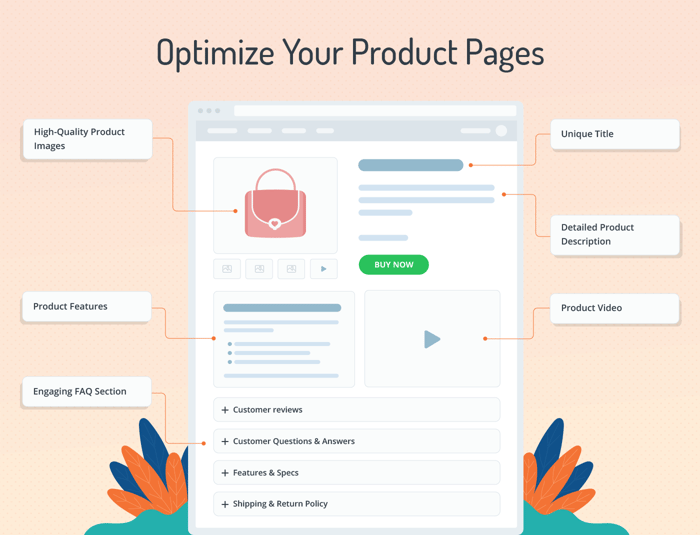
Categorize Your Products
Categorizing products is a great way to guarantee a smooth user experience.
Put yourself in your customer’s shoes. Imagine wanting a pair of sport shoes and landing on a beautiful online shoe shop only to find that you can’t find your size, your sport, or for that matter, any of the features you were looking for. And not because they don’t have what you want, but because the products are all over the place.
Not a pleasant user experience. You’d think twice before you visit that store again. And Google would think twice before it shows it to someone else.
So, categorize your products. BigCommerce is incredibly helpful in that respect. It allows you to group your products in logical sets and subsets (parent-child categories) with SEO-friendly category URLs and arrange them according to your needs.
Your categorization will depend largely on what you sell and how diverse your products are. For instance, if you sell mattresses, you can categorize them as Memory Foam, Twin, or King Size mattresses. If you sell knives, you can create categories like Survival, Bushcraft, and Kitchen knives.
In addition to creating intuitive categories, optimize your product category pages for SEO by writing suitable titles and meta descriptions.
On top of allowing an excellent user experience, product categories also help with website navigation. They allow website visitors to comprehend the hierarchical structure of product pages, know where they are at any given time, and understand precisely where to look to find what they need.
In that spirit, link to the product categories and subcategories in the navigation menu so users always see them and search for the desired product type without interrupting the flow of their actions.
Use Clean URLs
You should always try to use clean URLs for your website pages. A clean URL is descriptive, concise, and optimized with the proper keywords. Sometimes, you can or must sacrifice one quality at the expense of another, which is okay, but meeting all three should be your ultimate goal.
As we pointed out earlier, BigCommerce is quite helpful in this regard. It auto-generates SEO-friendly URLs for your product, category, and other web pages, and they all meet the criteria for clean URLs. However, if you want to customize these URLs, make changes so they stay as clean as possible.
Submit Your Sitemap
Finally, don’t forget to submit your sitemap to Google, Bing, or any other search engine you like.
As the name suggests, a sitemap is… well, a map of your site. It shows search engines the hierarchical structure of your e-commerce store and allows them to index your store’s pages so they rank and compete with similar content on the web.
Refer to the BigCommerce article on locating and submitting your sitemap to learn more on this topic.
Your BigCommerce Blog
The Benefits of Blogging
Blogging has tremendous benefits for increasing your online store’s visibility, which is why so many entrepreneurs have used it as their most precious marketing tool since the nineties.
Some of the regulars on the list of benefits are the following three:
A blog allows you to demonstrate your expertise and experience in a niche, which promotes trust in your readers.
A blog is an invaluable traffic source that allows users to engage with your website in ways that are not limited to a transactional relationship, which is a good thing (trust us).
A blog enables you to generate fresh content that catalyzes email marketing and social media promotion.
Keyword Research
Probably the single most important prerequisite for a successful blog is keyword research. It should be the backbone of your BigCommerce SEO strategies.
Keyword research eliminates the guesswork from blogging, turning it into a systematic and methodical undertaking. Solid keyword research tells you what’s relevant to the audience in your niche and, hence, what’s relevant for you to write about.
How to Do Keyword Research
To find the right keywords for your blog posts, start with… well, Google search.
Suppose you sell mattresses. Begin by typing the most general term in the search bar: “mattresses.” Scrolling up and down, you’ll soon notice patterns in the results, such as “best mattresses,” “best bed in a box mattresses,” “best mattresses in 2024,” and more. That will give you at least some idea about what to focus on and in which direction to proceed.
Wikipedia can be another helpful source of keyword ideas. If you type in ”mattress,” you’ll find that the article on this topic is a treasure trove of keywords. It’ll give you an insight into important subtopics in the mattress discussion, such as types of mattresses, ergonomics, construction, and lifespan, and provide a solid foundation for your further research.
But if you want to get into the nitty-gritty of your primary topic, specialized keyword research solutions are indispensable. They allow you to find the best keywords to cover and provide invaluable information on:
Keyword search volume
Keyword difficulty
Search intent behind keywords
Keyword variations
User questions related to keywords
Top ten search results on Google
The good news is that even the best commercial solutions typically offer free keyword research features. These features, although limited, are more than sufficient to carry out your research successfully, especially at the beginning of your blogging and SEO journey.
Semrush, MarketMuse, and Moz are among the most prominent platforms offering such features. In addition, they have tons of helpful guides on keyword research to help you on your way to successful blogging.
One caveat, though: Make sure that as you try to create content revolving around your most meaningful keywords, you don’t slide into keyword stuffing. Keyword stuffing means forcing targeted keywords into sentences and paragraphs where they don’t belong at all.
It’s one of the most distasteful and manipulative black-hat SEO tactics. And search engines give no quarter to websites using it.
Include Short-Tail and Long-Tail Keywords
Including both short-tail and long-tail keywords in your blog posts should be another important aspect of your keyword research strategy.
Short-tail keywords are typically more general and highly popular search terms, such as “SEO,” “cybersecurity,” and “exercise.” Conversely, long-tail keywords are usually more specific and less popular than short-tail keywords. Search terms like “best budget indoor exercise shoes in 2024” and “jazz clubs in Five Points Denver” would fall within long-tail keywords.
Both types of keywords are valuable.
On the one hand, if you strive for authority in a large industry, you’d want to create blog posts that target short-tail keywords. But keep in mind that, in that case, you’ll have to work patiently on refining your articles to get on the first page of Google.
On the other hand, to meet users’ highly specific search intents and solve concrete problems and subtle conundrums, create content on topics falling within the long-tail category. Since long-tail keywords are low-volume keywords, targeting them will allow you to rank higher much faster.
Why? Low volume means less to no competition – especially if you target so-called zero-volume keywords – which means more room to take advantage of untapped opportunities and become the expert for highly specialist topics.
Categorize Keywords
Yet another helpful tactic is to categorize keywords, that is, group them based on search intent. This practice is called keyword clustering.
Long-tail variations of your primary keyword – that is, the main topic of your article – along with its synonyms, usually make up a keyword cluster. For instance, “sneakers,” “sports shoes,” “athletic shoes,” “trainers,” “water resistant running footwear,” and “running shoes for flat feet and overpronation” would make a nice cluster together.
After you categorize related search terms together, you can use them in the same blog post (but only if that makes sense) or different articles. The point of this tactic is to allow users who search for what you offer but use other search terms to find you more easily.
Primary and Secondary Keywords
The keywords related to your primary keyword – synonyms and long-tail variants – are called secondary keywords. They allow a single blog page to rank for more than just one search query and, hence, attract more page visitors.
It’s good practice to cover only one primary keyword per blog post/page. When it comes to secondary keywords, you can include more, but try not to overdo it. Four to five secondary keywords per blog post would be a golden mean.
A good way to cover secondary keywords is to include them as subheadings. To find suitable secondary keywords for each of your blog posts, you can use the keyword research tools we mentioned earlier. They typically show a good number of keyword variants and subtopics for a given primary keyword.
Create a Content Plan
If you work out, you need a good workout plan to maximize your results. Everyone who has had success with exercising says that having a clear workout plan – what exercises you do, in what order, how many sets and reps, and how often – has been essential for them to see concrete results.
Just like working out (and virtually everything else), you need a content plan if you want to see concrete results from your blogging efforts.
A content plan in blogging means publishing blog posts on topics that make the most sense specifically for your e-commerce business and the products you offer. For instance, if you sell school backpacks, it would be a waste of time and effort to publish an article on rucksacks. Yes, a rucksack is a backpack, but it doesn’t make sense for your online store – because you don’t sell them.
Another key constituent of a content plan is order. It’s great to have a sequence for publishing your articles and stick to it. It goes without saying that this cannot be just any order. It must hinge on your content strategy and goals – that is, what you want to achieve within a certain time frame and how specific pieces of content help you with that.
Timing is yet another key aspect of content planning. How many times a week will you publish?
On which days? At what hours does it make the most sense? Do your resources allow frequent publishing? How would holidays and contingencies such as sickness affect your publishing schedule? These are some questions you need to factor in when creating your content plan.
You can find great online recommendations written by SEO experts on how to create a good content plan. Some SEO platforms and professionals even offer templates that you can use as a source of ideas for your own content plan. But the most important thing to know is that if you do keyword research properly, your content plan will grow naturally out of it.
It’s All About the User
Your blog posts will revolve around the products you sell and link to product pages, no doubt. However, be cautious: Promote your offerings in non-salesy, non-pushy, and non-intrusive ways. (We consider these the three pillars of good promotion.)
Always remember that people and their interests come first – SEO comes later. Chasing better rankings while losing sight of the user is like beating the wind.
You should base your blog posts on the guiding principle of helping people solve problems, answer questions, and acquire new knowledge. So, focus on topics that actually serve people and are not there just to fill space around your products.
In that spirit, avoid duplicate content.
Duplicate content is just like it sounds: content that’s a replica or slight variation of other content on the same or a different website. Content spinning – the practice of rewriting an original piece by using a lot of synonyms and different phrasing – also falls under the duplicate content rubric.
Google, for instance, strives to minimize redundancy and provide authentic, distinctive, informative, and unplagiarized information to users. This principle implies that duplicate content can only make things hard for you from an SEO standpoint.
In some cases, though rarely, Google can even completely de-index your website if it establishes that you were replicating other content for deceptive and manipulative reasons.
Start Your Journey with a Purpose-Built Blogging Platform
When launching a blog, your best bet is to use a dedicated blogging platform, such as DropInBlog.
DropInBlog integrates painlessly with BigCommerce and allows you to manage all the blog-related activities from one place, create a pleasant user experience, and work on better search engine rankings through its native SEO Analyzer.
Speaking of, the SEO Analyzer allows you to:
Add your primary and secondary keywords.
Add an SEO page title and meta description.
Calculate your content’s SEO performance.
Calculate the total SEO score of your blog post.
This SEO tool calculates the content score based on how your text performs in terms of word count, how often and where your primary keyword appears, whether you’ve added an H1 heading, whether you’ve added images to break the monotony of a long block of text, and other important factors.
In addition, the total SEO score takes into account the SEO page title and meta description as well.
When your blog post performs well in these areas, DropInBlog’s SEO Analyzer tells you precisely what is good about it. When there is room for improvement, it gives you specific guidelines on how to do it.
Another DropInBlog feature that comes in handy is the ability to add blog authors.
Regardless of whether your content team includes more than one writer or you simply prefer to be open to collaboration and guest posts, DropinBlog makes it easy to create and maintain a list of blog authors and add their bios, images, and social media links, so your audience knows who’s behind their favorite reads.
Apply On-Page SEO Techniques to Make Your Blog Count
Link to Your Blog in the Navigation Menu
The first and most obvious step is to add a link to your blog in the navigation menu. That way, your blog will be effortlessly accessible regardless of what page visitors land on.
Create Internal Links
Internal linking is when you link from one of your blog posts to another or, more generally, from one of your website pages to another. The rule is to link to the most important pages of your website.

For instance, you may write a blog post on adventure racing – what it is and why it’s so exciting and appealing despite being very challenging. It would be great to link from this blog post to, say, another of your blog posts discussing adventure racing gear and also from the latter to one of your product pages dedicated to a type of adventure running shoes you sell.
That way, you achieve multiple objectives:
You improve website navigation, making it easier for visitors and search engines to find content without getting lost in a labyrinth of pages.
You signal to Google which pages on your website are the most important, clustering meaningfully related content around them.
Meta Tags: Titles and Descriptions
Always strive to write captivating meta titles and descriptions for your blog posts.
A good meta title is on point, concise, and intriguing enough to make people want to click and at least skim over your blog post.
A good meta description informs and kindles interest in users by providing a short, relevant summary of a page’s content.
Meta descriptions resemble an elevator pitch or a call to action. On the one hand, they convince the user that a page is what they’ve been looking for. On the other hand, they announce the good news about how the content on the page will satisfy their curiosity and help them achieve their goals.
Header Tags
There are six levels of header tags, H1–H6, but you’ll rarely, if ever, go beyond H4.
Having one H1 heading per blog post is almost unanimously considered a good SEO practice. An H1 heading signifies your text’s title, and you can have only one title for each article. More than one H1 sends confusing signals to users and search engines, making them struggle to understand what the subject of your post/page is.
Another good practice is to move step by step through the sequence of headings and not jump, say, from an H1 directly to an H3 heading. Instead, the next heading level after an H1 should be an H2, and after an H2 the next level should be an H3, and so on.
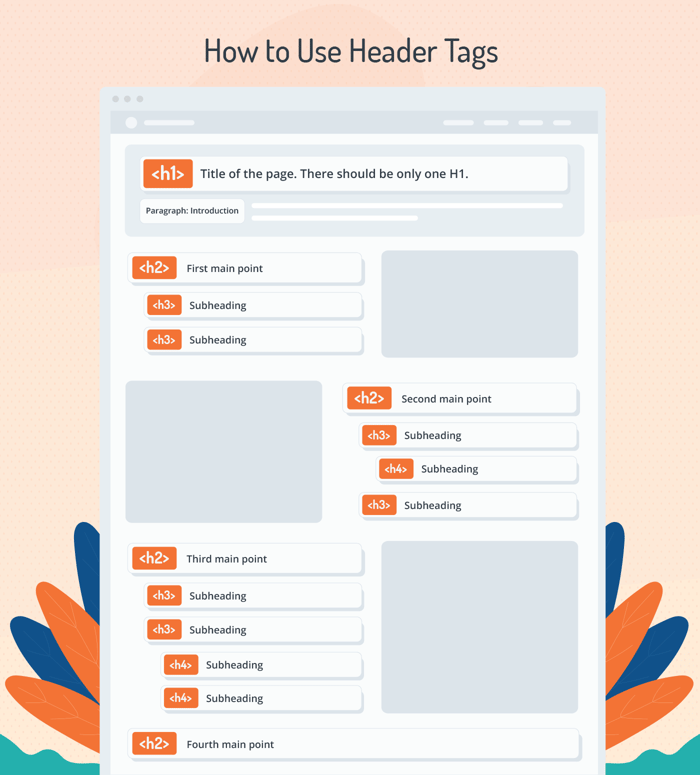
Add an FAQ Section
Adding an FAQ section to your blog posts makes them more user-friendly.
FAQs provide quick answers to important questions, which is why people love them. Anticipating the issues that users may be confused about and taking the time to answer them beforehand shows that you understand and care about your customers.
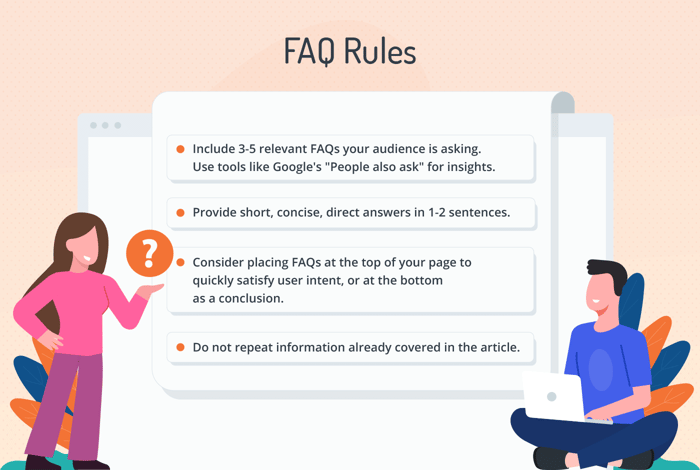
We highly recommend that you use the FAQ schema when creating an FAQ section. This can make your blog page suitable for rich snippets.
Categorize Your Blog Posts
Blog categories, too, can improve your blog’s user-friendliness by bringing order to chaos or adding even more order to an already tidy blog.

Meaningful blog post categories make for a well-organized and easy-to-navigate blog, which creates an enjoyable user experience – something you should always strive for.
If you built your blog with DropInBlog, adding categories to your blog can easily be done in a few minutes.
Add Rich Media
Rich media includes images, videos, infographics, GIFs, and more.
You can never go wrong with rich media in your blog posts. Adding relevant visual content in suitable places is a good idea, if not for other reasons, because it breaks the monotony of long, dense walls of text.
Rich content can tell stories, create emotional connections, and simplify complex information, making your content more engaging and effective.
Due to their strong appeal, the presence of images and videos in your blog posts increases the probability of your readers sharing your content elsewhere, which can benefit your SEO rankings.
Image SEO
When we say image SEO, we mean three things:
Compressing large images (without destroying their quality)
Writing descriptive file names
Adding explanatory alt text
Not that these three elements are not all there is to image search engine optimization, but they’re crucial.
Large images, especially if you have a bunch of them, can slow down your page load time, which adversely affects user experience. And you don’t want that. No one wants that.
Fortunately, if you’re using DropInBlog, all the images you upload are auto-compressed and optimized so this point is all taken care of for you.
The alt text is also sometimes referred to as an alt tag. Technically, it’s an HTML attribute, not a tag, meaning alt text would be more accurate. However, many people, including SEO professionals, use them interchangeably.
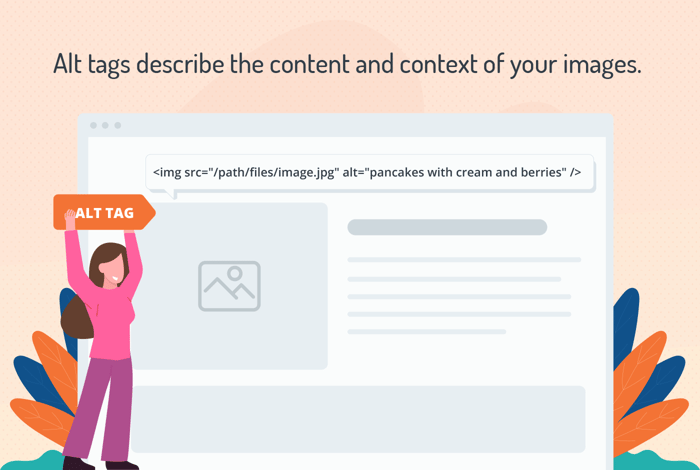
The alt tag serves as an image description for both search engines and screen readers. The latter implies that, aside from helping with SEO, it also helps with accessibility.
Search engines and screen readers read the image alt tag to interpret and understand the image’s content. Since the alt tag describes images, it should be short and descriptive.
Although adding an alt tag to your images is highly recommended, not all of them require it. For instance, pictures in purely decorative roles do not need them.
Similar to the alt tag, image file names also help search engines learn what the image shows.
Long file names are not recommended. Instead, try to limit your image file name to a keyword or short keyword phrase you’re targeting.
Encourage Customer Reviews
Encourage customers to leave reviews of your products and display their reviews below the products. When users leave written feedback, they use keywords, even unintentionally, which helps Google learn more about your business, understand it better, and show it as a relevant search result.
Always provide authentic, honest reviews. In other words, don’t hire people to write good reviews for you or remove the ones that are not the most flattering.
Don’t be afraid of bad feedback. Your products can be completely flawless and someone will still find faults in them. On the other hand, if people react negatively to the same aspect of your product or service, see this as an opportunity to raise the quality of your offering and keep your customers happy.
Despite a few bad reviews here and there, if you try hard, your effort will show in what you offer, and most people will leave you a good review.
And when real people leave real reviews, that helps with credibility. Others will know that your online shop is not a scam and that your products deserve their time and attention. People like to read about other people’s experiences and tend to trust them more than the businesses’ words. Google, too, trusts your site more when your customers give good, genuine feedback.
Accumulating a large number of authentic positive reviews will positively affect your search engine rankings. They bring more online visibility since Google will push your content higher in the SERPs. More visibility tends to lead to a higher click-through rate, which is always good for your business.
Also, keep in mind that Google favors user-generated content, so encourage your customers to post pictures or videos of themselves and their friends using your products, along with a written review.
While we’re at it, make writing a review as simple as possible. For instance, you can add an “Add a Review” button to your product pages. The button could lead to a simple review submission form that doesn’t annoy people with a whole heap of questions and a bunch of information requests.
Or, even better, automate the entire process. For example, any user who makes a purchase could automatically get a prompt to leave a review.
By the way, don’t worry that asking for feedback will bother your customer.
Firstly, stats show that the majority of users are willing to leave a review, especially after a positive experience with your product or service, such as a purchase.
Secondly, if you personalize your ask – say, by using the customer’s name and the product they chose in your review prompt or post-purchase email – instead of approaching in an impersonal or pushy way, there’s not much to worry about. Chances are customers won’t feel it’s an intrusion at all.
Analyze SEO Performance
You’ve probably heard some variant of the saying, “You cannot improve what you do not measure.” That definitely applies to SEO.
Without knowing what works and what doesn’t, what content gets clicks and shares and what gets skipped, where most of your blog and store visitors come from, what pages get the most traffic, and so on, it would be next to impossible to make adjustments for the better or build a long-term SEO strategy.
In that respect, tools and methods for monitoring SEO performance such as Google Analytics 4 (GA4) are invaluable.
Integrating GA4 is a no-brainer. It’s free and includes a ton of functionality that can help you track and analyze SEO-relevant data. BigCommerce has a great guide on how to set up GA4 for your online store, so refer to it when integrating this tool.
Furthermore, GA4 integrates with DropInBlog so you can easily track your blog post performance from right within the dashboard.

Some of the key SEO-related metrics to track on Google Analytics are the following:
Views
Users
New Users
Engagement Rate
Engagement Time
Refer to the BigCommerce guide to SEO tracking and measuring for more information.
Even if GA4 were the only free analytics solution out there, it would’ve still been great, and we would’ve still been thankful for it. However, we’re even luckier than that. Bing Webmaster Tools and Google Search Console are two other powerful SEO analytics solutions, and they’re both free, so don’t hesitate to use them.
Google Search Console has been especially popular and is one of the indispensable tools pros have been using for years. It’s extremely helpful in finding technical issues – page redirect errors, crawl issues, 404 error codes, server errors, and similar – and problems with indexing.
However, it goes without saying that it also provides critical information on SEO performance measurables, such as clicks, CTR, average page position, and more.
Advanced SEO Tactics and Best Practices
Backlink Building
Sometimes, creating original, high-quality content is just not enough. The target keyword may be extremely competitive, and you’ll be up against industry giants with high domain authority and long-established credibility. To stand a fighting chance, you need a solid and well-thought-out backlink strategy.
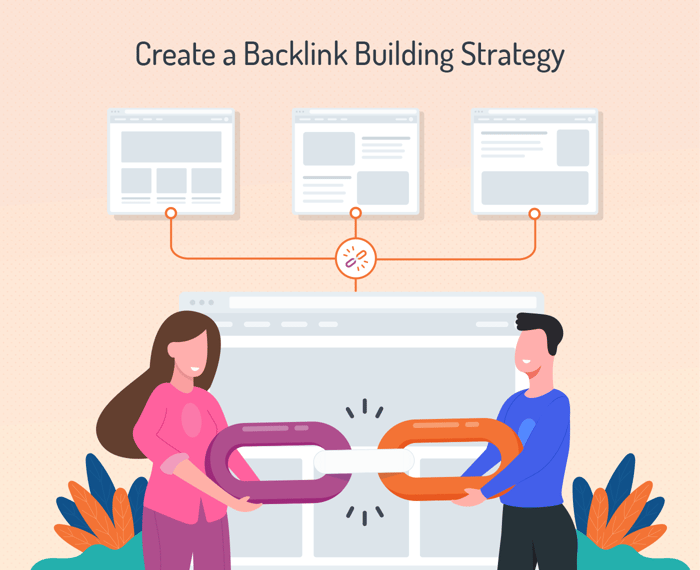
To say that backlinks help improve your SEO is an understatement. Beyond a certain point, they become practically indispensable. But backlink building is a serious endeavor whose successful realization requires undying patience, and a lot of reaching out.
Backlinks’ SEO significance comes from the fact that they represent public recognition of your expertise and authority in the niche. Each backlink is a vote of confidence from other sites for your site. Therefore, as a general rule, the more backlinks your website has, the higher it can rank for search terms.
However, besides quantity, the quality of your backlinks also counts. There’s a world of difference between whether it’s Harvard Health Publishing or your local medical high school’s website that links to your article on, say, the optimal amount of daily protein intake for physically active people.
The higher authority and the more relevant the website that links to your content, the better the quality of the backlink.
As far as techniques for building backlinks go, you can try the following and see which works best for you:
Doing PR – interviews, features, podcasts, and similar – to promote your online store
Practicing guest blogging – writing articles on other websites or e-commerce stores that allow you to link to your store
Creating linkable assets, such as infographics and other rich media content, that others can link to
Submitting your site to business directories and listing sites
Targeting link roundups
Posting to relevant forums and comment sections
Collaborating with influencers who are willing to promote your products
Introducing your products to review websites where people leave feedback and link back to product pages
The Importance of UX
UX includes your store’s visual design as an essential component but goes way beyond that. UX is also:
Intuitive navigation
Efficient search functionality
Uninterrupted checkout process
Quick load time
Up-to-date accessibility features
Effective, user-centric copywriting
These, more or less, overlap with good technical and on-page SEO practices. Hence, when you implement good UX practices, you propel yourself towards achieving your SEO goals.
Good UX can bring multiple benefits to your e-commerce business, such as:
Increase in users’ engagement and time on site
Lower bounce and cart abandonment rates
More page views per session
We’ve only scratched the surface here, so if you’d like to research the topic further, you should definitely have a look at this guide on e-commerce UX best practices.
SEO Updates and Trends
To ensure that your SEO practices stay current and effective, you should keep up with evolving SEO algorithms and trends.
Google Search makes thousands of small changes each year. Fortunately, only several of those are critical core updates.
It’s not that you should obsess with every core update and subsequent proclamation that SEO as we know it is dead and a brand new SEO era has begun. However, you must at least stay in the loop and see if the changes to the search algorithm require sweeping, tiny, or no intervention at all on your e-commerce website.
In addition, keep your eye on the latest SEO trends, but don’t just jump on the bandwagon. For instance, AI SEO tools have been much talked about and used in content creation for a while now.
Do your research and see what AI-based tool would work for you, if any. If it’s key to better SEO and makes sense to you, use it. If not, don’t force yourself to catch up with trends just because others did it. Otherwise, you may end up producing tons of highly unremarkable and barely readable marketing gibberish full of words like “delve,” “ever-evolving,” and similar.
Conclusion
Use everything that BigCommerce offers in the SEO realm that you find helpful. Don’t neglect the basics of your e-commerce store and optimize your product pages for search engine rankings, but don’t stop there.
Launch a blog, do diligent keyword research before you write an article, link to your already published blog posts, add appealing visuals, measure what you do, and stay updated on search algorithms and best practices. Most importantly, never forget that everything you do in SEO should revolve around the user.
If you have any questions about the topic of BigCommerce SEO strategies or DropInBlog, let us know – we’d be happy to hear from you.
